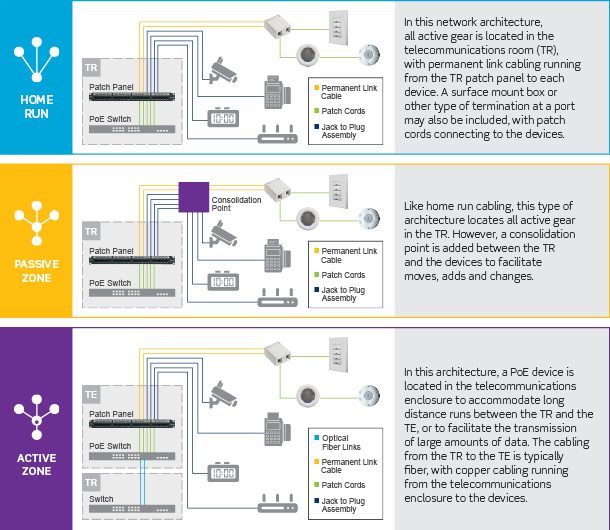Why Zone Cabling Architectures Make Sense

When Power over Ethernet (PoE) was introduced in 2003, it was available for only a handful of low-power operations and devices. Today, PoE is one of the fastest growing networking applications. A wide range of enterprise devices and technology rely on PoE, including lighting, access controls, laptops and desktop computers, IP cameras, information kiosks, industrial automation equipment, and wireless access points (WAPs). With the advent of digital buildings and the Internet of Things (IoT), PoE is poised for unprecedented expansion in the enterprise.
To leverage the many capabilities of PoE, network designers are increasingly turning to zone cabling architectures as an alternative to traditional home run cabling in digital buildings.
There are three basic topologies commonly implemented when designing for PoE systems: home run, passive zone, and active zone architectures.

There is no one-size-fits all topology for PoE, and each architecture offers advantages and disadvantages. However, for high-power PoE, passive and active zone architectures create some clear benefits.
While a traditional home run scenario makes it easy to manage active equipment and power – as it is centralized in the TR – the cabling infrastructure is much less flexible, making future moves, adds, and changes (MACs) more difficult.
In the passive zone topology, all active equipment and power is also centralized in the TR. But unlike the home run, the added consolidation point creates the flexibility of not having to provide cabling all the way back to the TR. Instead, it includes a break point in the middle that allows for adjustments. This provides a big advantage in environments like open offices, where work spaces or cubicles are often reconfigured and moved around.
An active zone design reduces the size requirement for the telecommunications room by running optical fiber from the TR to zone enclosures, and copper cabling from the enclosures to the device outlets. Moving the PoE switch from the TR to the zone enclosure – and closer to the end device – reduces energy loss in cables. In addition, smaller PoE switches used in zone enclosures are generally more cost effective than larger switches housed in a TR.
Zone cabling options also have a lower cost after installation ("day two cost"). There are, however, several disadvantages to using zone cabling. These include a higher initial cost and fewer measurable benefits to fixed workspaces where MACs are rare.
Overall, by implementing zone cabling – particularly passive and active zone architectures – the capabilities of PoE can be successfully leveraged throughout the enterprise.
To learn more, visit our Digital Buildings page.


